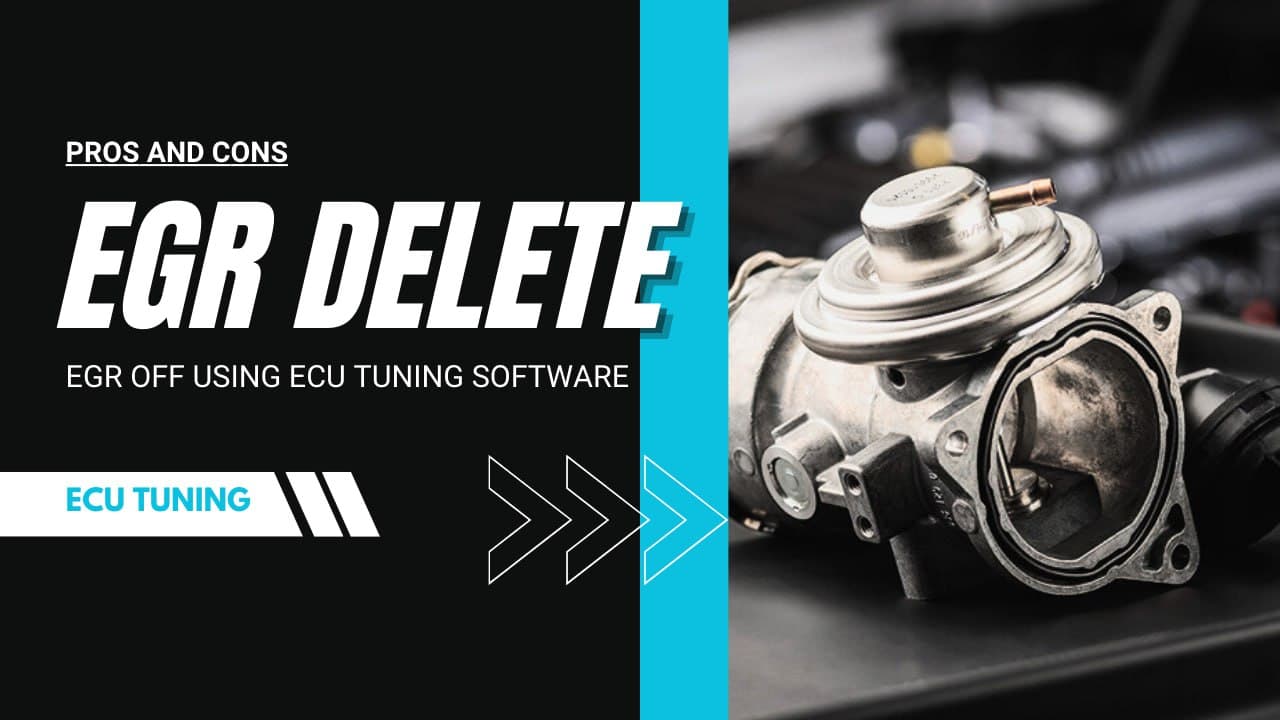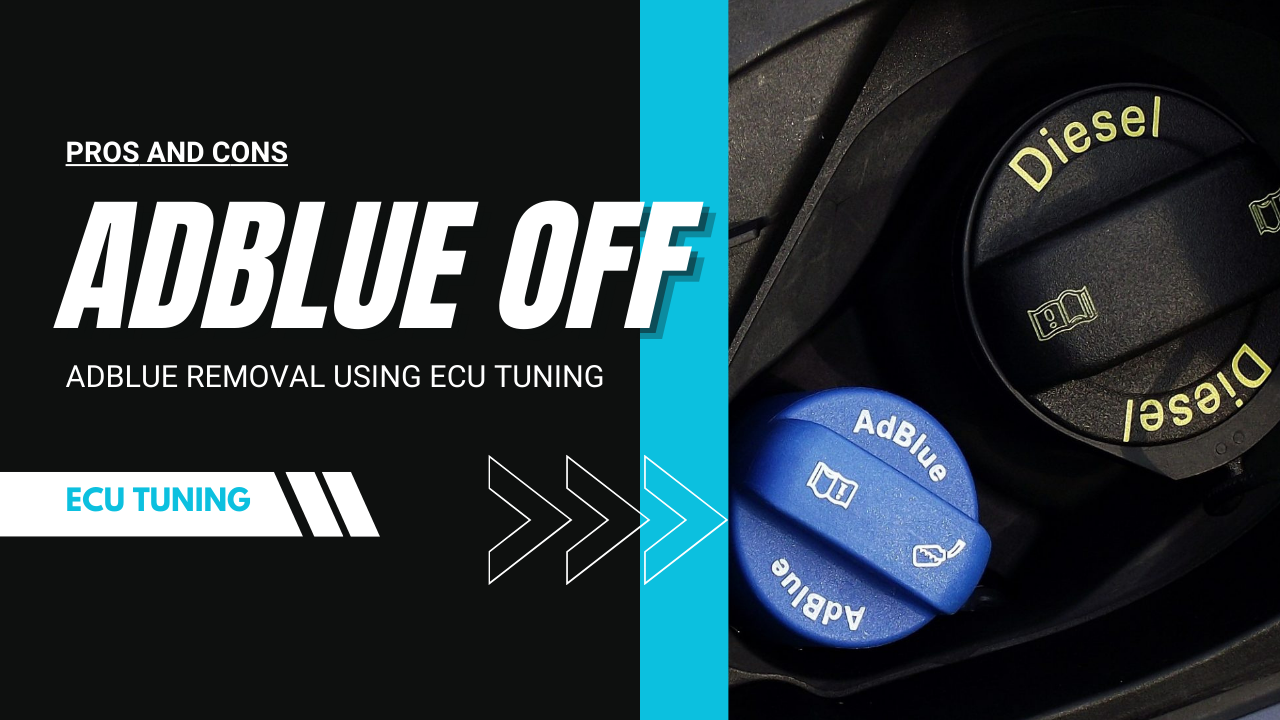
EGR Delete/EGR OFF Service/Everything You Should Know About EGR Removal
EGR Delete/EGR OFF Service/Everything You Should Know About EGR Removal
What is EGR OFF?
EGR Off refers to disabling or bypassing the exhaust gas recirculation (EGR) system in an engine, typically through ECU (engine control unit) remapping or physical modifications. The EGR system is designed to reduce harmful emissions by recirculating a portion of the exhaust gases back into the engine's intake to lower combustion temperatures and reduce nitrogen oxide (NOx) emissions. When the system is disabled, it prevents exhaust gases from being reintroduced into the combustion process. This modification is often sought by car owners for performance enhancements or to avoid EGR-related issues. However, it is important to note that "EGR Off" is illegal in many regions due to environmental regulations.
EGR Delete Pros & Cons
Removing the EGR, like other system removals, such as DPF, AdBlue, DeCat, and others, can be beneficial and also have disadvantages at the same time. We will go through benefits and problems that occur after deleting EGR.
Disabling the EGR prevents exhaust gases from recirculating into the engine, which allows for cleaner combustion and better throttle response. However, it leads to the increase of nitrogen oxides (NOx), a harmful pollutant. Disabling it can lead to significantly higher emissions, contributing to environmental damage.
Pros or EGR delete benefits:
- Improved Engine Performance
- Increased Fuel Efficiency
- Reduced Carbon Build-Up
- Enhanced Engine Longevity
- Cost Savings
- Better Suitability for Performance Tuning
Cons or EGR delete disadvantages:
- Increased NOx Emissions
- Legal Implications
- Voided Manufacturer Warranty
- Compatibility Issues
- Potential Overheating Risks
- Impact on Resale Value
How To Delete EGR?
First of all, you should be aware of the fact that EGR removal is illegal, causes NOx emissions to increase, and voids the vehicle's warranty.
There are two ways to disable EGR: Physical Removal and Software Removal Using ECU Remapping
Physical Removal:
You can locate the EGR valve and disconnect its vacuum lines and sensors, then seal the ports on the intake and exhaust manifolds using blanking plates to prevent exhaust gases from recirculating. There are also EGR delete kits available in order to ease the process.
There are also downsides to this method like:
- The engine may experience and increase in the exhaust gas temperature (EGT)
- It can cause the car to knock.
- Stock cars are not allowed to use these KITs in most regions, and your vehicle fails the emission tests.
- It is only allowed for off-road cars.
- Error Codes and Check Engine Light
Instead, we recommend another method which is way more efficient.
Removal Using ECU Remapping:
If you have a diesel car and you have problems with its EGR system, such as low engine performance, check engine light, repair costs and etc., this issue is solved by remapping the ECU software and disabling it once and for all.
EGR Delete Software
To remove EGR from ECU, communication tools such as KESS3, Alientech KTAG, Dimsport New Genius, or Autotuner can be used for reading and writing the ECU data. And for remapping the ECU file you can use software such as Swiftec, RaceEvo, and ECM Titanium. But sometimes these software don’t have EGR maps for every car so you should choose appropriate software for each vehicle and correctly identify the tables related to EGR removal. The only software that can be used for every ECU file is WinOLS, which is the most challenging as it needs a lot of practice and knowledge in order to find and modify required maps for EGR .
Our technicians at schiller tuning have over a decade of experience in the WinOLS software and can identify and modify EGR related maps no matter the ECU or the car model.
You can use our ECU tuning services, such as EGR, DPF, or AdBlue/SCR OFF; in order to do that, you need to have your car’s original ECU file. If you’re a tuner, you can read the file using one of the programmers we introduced, or if you’re the car owner, you can reach out to the nearest dealership in your area to read the original ECU file and then upload it to our Tuning File Service. After a short while, our experts will send you the remapped file.
How to Delete EGR from ECU Using Remap
The shown table is the EGR value map inside an ECU file. As you can see the vertical axis of the table is the RPM and the horizontal axis is exhaust smoke recirculation based on milligram per stroke. For example in 3000 RPM, 50 mg/stk of smoke returns back into the intake manifold.
This is a 2D view of an EGR duty cycle.
In actual fact these numbers determine the opening rate of the EGR Valve. It is clear that if we want the valve to not open ever we should set all the numbers in all RPMS to 0, as shown in the picture. This way the valve never even open so why bother physically removing it 😊.
Is EGR OFF Illegal?
Yes, EGR Deleteis illegal in many regions worldwide due to its environmental impact. Here’s why:
Why Is It Illegal?
Most vehicles are certified under strict emissions regulations, such as Euro standards in Europe or EPA standards in the U.S. Disabling emissions control systems like the EGR violates these certifications.
Where Is It Allowed?
EGR Off may be permitted for vehicles used exclusively off-road, such as racing or agricultural equipment, depending on local laws. However, even in these cases, specific permits or exemptions might be required.
Fault Codes for EGR?
The most common fault/trouble codes related to EGR are P040x codes. The popular EGR error is :
P0400: EGR flow malfunction
P0401: EGR insufficient flow
P0402: EGR excessive flow
P0403: EGR circuit malfunction
P0404: EGR circuit range/performance
detects that the expected amount of exhaust gas is not recirculating back into the engine’s intake manifold.
For example in Volkswagen Passat TDI with the EDC17C46 ECU, codes like P0402 & P0403 appear commonly.
At schiller tuning we do EGR off for all types of cars by ecu remap. You can also join our EGR removal training course where we teach you how to delete EGR DTC codes from different ECUs. And if you want to do any DTC OFFs you can send us your ECU file to our ECU Tuning Service, and our experts will send you the remapped file in a short time.
How much does a EGR Delete Cost?
The price of EGR removal depends on a combination of vehicle type, ECU complexity, required customization, and the tools used. Simple ECU files in common models typically cost less, while advanced ECU systems in luxury cars demand higher service fees due to specialized expertise. Vehicle owners should consider these factors and consult experienced tuning professionals to ensure a safe and legally compliant EGR removal process.
How much bhp does EGR delete add?
Removing or disabling the EGR system typically doesn't lead to a significant increase in horsepower, as the change to the air mixture in your engine’s combustion chambers is minimal. Although EGR deletes can result in a cleaner air-fuel ratio, the performance boost is relatively small, usually adding between 0 to 5 horsepower at most. The gains are modest, and while the engine may run more efficiently, the increase in power isn't substantial.
Can You Delete EGR Without Deleting DPF?
Yes, it is technically feasible to remove the EGR system while keeping the DPF intact. However, doing so can cause complications, such as a buildup of soot in the DPF and elevated exhaust gas temperatures. This can result in potential damage to the DPF, leading to reduced engine performance and more frequent maintenance issues.
Does EGR delete increase engine life Diesel?
Removing the EGR system can help prolong engine life by minimizing carbon buildup and preventing issues related to EGR failure. However, it’s important to note that higher combustion temperatures caused by the removal could lead to increased wear on certain engine components over time.
In conclusion:
While EGR removal, commonly referred to as "EGR Off," offers significant advantages such as improved engine performance, reduced carbon buildup, and enhanced suitability for tuning, it also comes with substantial drawbacks. The increase in nitrogen oxide (NOx) emissions poses serious environmental concerns, and the legal and warranty implications make it a controversial choice.
While physical removal provides a straightforward solution, software-based removal via ECU remapping stands out as a more efficient and precise method for disabling the EGR system. However, due to the technical complexities involved and the potential risks to both the vehicle and the environment, it is critical to approach EGR removal with caution. It is essential to rely on skilled professionals and ensure compliance with local regulations to balance the benefits of performance enhancements with broader legal and ethical responsibilities.
Contact us: Contact us easily via WhatsApp at +45 55 22 92 98
Email: [email protected] We’re here to help!
If you found this helpful, please consider sharing it with others!
FAQs:
Is EGR removal legal?
No, disabling the EGR system is illegal in many regions due to increased nitrogen oxide (NOx) emissions and violation of emissions regulations. It may be allowed only for off-road vehicles in certain areas.
Related Articles:

AdBlue Delete /Everything You Should Know About AdBlue Removal software and ECU
will learn methods, advantages, and disadvantages of removing AdBlue using ECU remapping and kits, as well as the software and tools needed for this process.

Alientech K-TAG programmer / Clone VS Original
Alientech K-TAG programmer,K-TAG master vs slave, Differences of KESS & KTAG, Original KTAG vs Clone, How to use K-TAG, K-TAG price

Diesel AFR vs Lambda - Everything About the Diesel Lambda Air/Fuel Ratio
Learn about Diesel AFR vs Lambda, how to convert Lambda to AFR Formula, and the best AFR for power. Explore the Lambda air/fuel ratio chart for Diesel engine.
Comments
No comments yet. Be the first to comment!